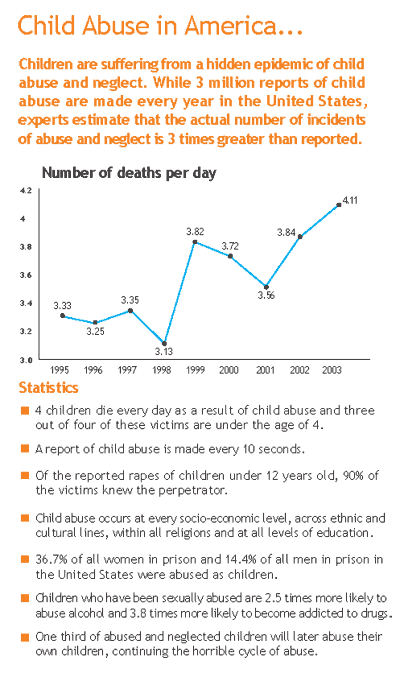Home --> Abuse Awareness --> Abuse Statistics
Abuse Statistics
Experts cannot agree on a single reason for this increase, but most attribute it to both a population increase and an increase in reporting. Other factors that are sometimes cited include changing a wider definition of child abuse, increased reporting requirements, states providing more accurate information, better recording systems, and changes in data collections.
Child Abuse Statistics in the USA
* An estimated 906,000
children are victims of abuse & neglect every year. The rate of
victimization is 12.3 children per 1,000 children
* Children ages 0-3 are the most likely to experience abuse. They are
victimized at a rate of 16.4 per 1,000
* 1,500 children die every year from child abuse and neglect. That is
just over 4 fatalities every day.
* 79% of the children killed are younger than 4.

(Chart courtesy ChildHelp
USA)
Consequences of Child Abuse and Neglect in USA
* 80% of young adults
who had been abused met the diagnostic criteria for at least 1 psychiatric
disorder at the age of 21 (including depression, anxiety, eating disorders,
& post-traumatic stress disorder)
* Abused children are 25% more likely to experience teen pregnancy
* Children who experience child abuse & neglect are 59% more likely
to be arrested as a juvenile, 28% more likely to be arrested as an adult,
and 30% more likely to commit violent crime.
* 14.4% of all men in prison in the United States were abused as children
and 36.7% of all women in prison were abused as children
* Children who have been sexually abused are 2.5 times more likely develop
alcohol abuse
* Children who have been sexually abused are 3.8 times more likely develop
drug addictions
* Nearly 2/3’s of the people in treatment for drug abuse reported
being abused as children
Cycle of Abuse in USA
1/3 of abused and neglected children will eventually victimize their own children
Additional Statistics on Child Abuse in USA
* There are nearly
3 million reports of child abuse made annually
* In 2003, there were 906,000 child abuse convictions
* The rate of child abuse is estimated to be 3 times greater than is
reported.
* The rate of victimization is 12.3 children per 1,000 children
* Children ages 0-3 are the most likely to experience abuse. They are
victimized at a rate of 16.4 per 1,000
* 79% of the children killed are younger than 4.
* These statistics are from the Administration for Children & Families
of the US Department of Health & Human Services “Child Maltreatment
Report 2003”
Consequences of Child Abuse in the USA
* 80% of young adults
who had been abused met the diagnostic criteria for at least 1 psychiatric
disorder at the age of 21 (including depression, anxiety, eating disorders,
& post-traumatic stress disorder)
* Abused children are 25% more likely to experience teen pregnancy
* Abused teens are 3 times less likely to practice safe sex, putting
them at greater risk for STDs
* These statistics are from the National Clearinghouse on Child Abuse
& Neglect Information. Long-term Consequences of Child Abuse &
Neglect 2005
The Link Between Abuse As a Child & Future Criminal Behavior
* 14.4% of all men
in prison in the USA were abused as children
* 36.7% of all women in prison were abused as children
* Children who experience child abuse & neglect are 59% more likely
to be arrested as a juvenile, 28% more likely to be arrested as an adult,
and 30% more likely to commit violent crime.
These statistics are compiled from US Department of Justice Reports
The Link Between Child Abuse & Substance Abuse
* Children who have
been sexually abused are 2.5 times more likely develop alcohol abuse
* Children who have been sexually abused are 3.8 times more likely develop
drug addictions
* Nearly 2/3’s of the people in treatment for drug abuse reported
being abused as children
These statistics are compiled from the National Institute on Drug Abuse 2000 Report & Child Abuse & Neglect Study by Arthur Becker-Weidman PhD
~~~~~~~~~~~~~~~~~~~~~~~~~~~~~~~~~
What
Is...? (Abuses Defined)
Signs of Abuse
How
To Help Prevent Further Abuse
Where To Find
Help
Links